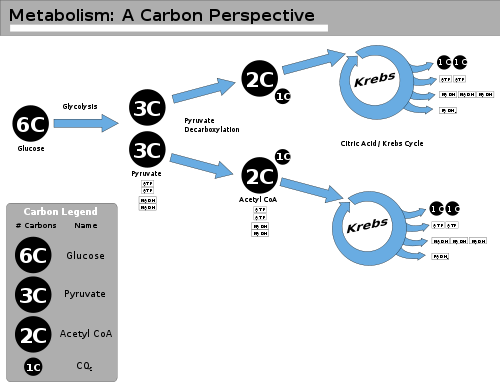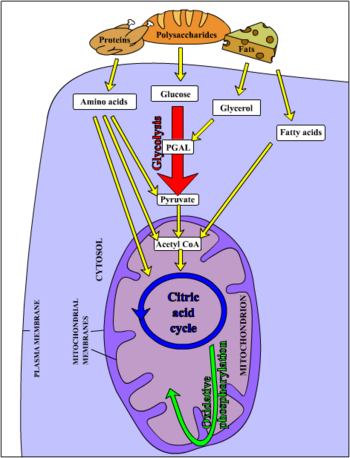Metabolism
Metabolism (from μεταβολισμος ("metabolismos")) is the biochemical modification of chemical compounds in living organisms and cells. This includes the biosynthesis of complex organic molecules (anabolism) and their breakdown (catabolism). Metabolism usually consists of sequences of enzymatic steps, also called metabolic pathways. The total metabolism includes all biochemical processes of an organism. The cell metabolism includes all chemical processes in a cell.
Cell metabolism
Cell metabolism is the process (or really the sum of many ongoing individual processes) by which living cells process nutrient molecules and maintain a living state. Metabolism has two distinct divisions: anabolism, in which a cell uses energy and reducing power (ability to reduce, or add electrons to a molecule) to construct complex molecules and perform other life functions such a creating cellular structure; and catabolism, in which a cell breaks down complex molecules to yield energy and reducing power. Cell metabolism involves extremely complex sequences of controlled chemical reactions called metabolic pathways.
History
The term "metabolism" is derived from the Greek word for "change", or "overthrow" (Etymonline)). The first controlled experiments in human metabolism were published by Santorio Santorio in 1614 in his book Ars de statica medecina that made him famous throughout Europe. He describes his long series of experiments in which he weighed himself in a chair suspended from a steelyard balance (see image), before and after eating, sleeping, working, sex, fasting, depriving from drinking, and excreting. He found that by far the greatest part of the food he took in was lost from the body through perspiratio insensibilis (insensible perspiration).
Metabolic pathways
Important metabolic pathways include the following:
Anabolism
Anabolism is the part of metabolism that builds larger molecules. One way of categorizing metabolic processes, whether at the cellular, organ or organism level is as anabolic or catabolic.
Anabolic processes tend toward "building up" organs and tissues. These processes produce growth and differentiation of cells and increase in body size. Examples of anabolic processes include growth and mineralization of bone and increase of muscle mass.
Anabolic pathways that create building blocks and compounds from simple precursors include the following:
- Glycogenesis (conversion of glucose into glycogen, a storage molecule for glucose)
- Gluconeogenesis (formation of glucose from non-sugar carbon substrates)
- Porphyrin synthesis pathway
- HMG-CoA reductase pathway, leading to cholesterol and isoprenoids.
- Secondary metabolism, or metabolic pathways that are not essential for growth, development or reproduction, but that usually have ecological function.
- Photosynthesis
- Light-dependent reaction (light reaction, or the reaction in photosynthesis that requires light to occur)
- Light-independent reaction (dark reaction, or the reaction in photosynthesis that does not require light to occur)
- Calvin cycle (a reaction in photosynthesis taking place in the stroma of chloroplasts)
- Carbon fixation (transformation of carbon dioxide into larger carbon-based molecules)
- Glyoxylate cycle (reaction involving the conversioin of two acetyl-CoA molecules into oxaloacetate)
Catabolism
Catabolism is the part of metabolism that breaks down molecules into smaller units. It is made up of degradative chemical reactions in the living cell. Large polymeric molecules (polysaccharides, nucleic acids and proteins) are processed into their constituent monomeric units (i.e. monosaccharides, nucleotides and amino acids, respectively).
Cells use monomers to construct new polymeric molecules or disassemble them to simple cellular metabolites (lactic acid, acetic acid, carbon dioxide, ammonia, urea, etc.). The creation of cellular metabolites is an oxidation process involving a release of chemical free energy, some of which is lost as heat and some of which is conserved through the coupled synthesis of adenosine triphosphate (ATP). The hydrolysis of ATP is subsequently used to drive almost every energy-requiring reaction in the cell. Thus, catabolism provides the chemical energy necessary for the maintenance of the living cell. Examples of catabolic processes include breakdown of muscle protein in order to use amino acids as substrates for gluconeogenesis, and breakdown of fat in adipose cells (fat-storage cells) to fatty acids.
Because it is counterproductive to have anabolic and catabolic processes occurring in cells simultaneously, there are many signals that switch on anabolic processes while switching off catabolic processes and vice versa. Most of the known signals are hormones and the molecules involved in metabolism itself. Endocrinologists (those who study the endocrine system, or the system of ductless glands that release certain hormones into the bloodstream) have traditionally classified many of the hormones as anabolic or catabolic.
- Classic anabolic hormones include
- Growth hormone
- IGF1 and other insulin-like growth factors
- Insulin
- Testosterone
- Estrogen
- Classic catabolic hormones include
- Cortisol
- Glucagon
- Adrenalin and other catecholamines
- Cytokines
- Newer hormones associated with the balance of the catabolic and anabolic states include
- Orexin and Hypocretin (a hormone pair)
- Melatonin
Carbohydrate catabolism
Carbohydrate catabolism is the breakdown of carbohydrates into smaller units. The empirical formula for carbohydrates, like that of their monomer counterparts, is CX(H2YOY). Carbohydrates literally undergo combustion to retrieve the large amounts of energy in their bonds. Read more about mitochondria to find out more about the reaction and how its energy is secured in ATP.
The smooth endoplasmic reticulum is responsible for some carbohydrate metabolism. In the liver, for example, the cell breaks down the polysaccharide glycogen. Eventually, the glycogen will be turned into glucose, and released into the blood, but first it is broken into glucose phosphate, an ion that, if released would harm our blood cells. So to remedy this, an enzyme found in the membrane of the smooth endoplasmic reticulum can remove the phosphate, allowing pure glucose to be released.
Fat catabolism
Fat catabolism, also known as lipid catabolism, is the process of lipids or phospholipids being broken down by lipases. The opposite of fat catabolism is fat anabolism, involving the storage of energy, and the building of membranes.
Protein catabolism
Protein catabolism is the breakdown of proteins into amino acids and simple derivative compounds, for transport into the cell through the plasma membrane and ultimately for the polymerization into new proteins via the use of ribonucleic acids (RNA) and ribosomes.
Drug metabolism
Drug metabolism pathways use specialized enzyme systems to modify or degrade drugs and other xenobiotic compounds (chemicals found in an organism which are not normally produced or expected to be present, or which are present at unusually high concentrations). Examples include the following:
- Cytochrome P450 oxidase system
- Flavin-containing monooxygenase system
- Alcohol metabolism
General pathways
- Carbohydrate metabolism
- Fatty acid metabolism
- Protein metabolism
- Nucleic Acid metabolism
Fatty acid metabolism
Fatty acids are an important source of energy for many organisms. Triglycerides yield more than twice as much energy for the same mass as do carbohydrates or proteins. All cell membranes are built up of phospholipids, each of which contains two fatty acids. Fatty acids are also commonly used for protein modification, and all steroid hormones are ultimately derived from fatty acids. The metabolism of fatty acids, therefore, consists of catabolic processes which generate energy and primary metabolites from fatty acids, and anabolic processes which create biologically important molecules from fatty acids and other dietary carbon sources.
Fatty acids, stored as triglycerides in an organism, are an important source of energy because they are both reduced and anhydrous. The energy yield from a gram of fatty acids is approximately 9 kcal (39 kJ), compared to 4 kcal/g (17 kJ/g) for proteins and carbohydrates. Since fatty acids are non-polar molecules, they can be stored in a relatively anhydrous (water free) environment. Carbohydrates, on the other hand, are more highly hydrated. For example, 1 g of glycogen can bind approximately 2 g of water, which translates to 1.33 kcal/g (4 kcal/3 g). This means that fatty acids can hold more than six times the amount of energy. Put another way, if the human body relied on carbohydrates to store energy, then a person would need to carry 67.5 lb (31 kg) of glycogen to have the equivalent energy of 10 lb (5 kg) of fat.
Nitrogen metabolism
Nitrogen metabolism includes the pathways for turnover and excretion of nitrogen in organisms as well as the biological processes of the biogeochemical nitrogen cycle:
- Urea cycle, important for excretion of nitrogen as urea.
- Biological nitrogen fixation
- Nitrogen assimilation
- Nitrification
- Denitrification
External links
- Interactive Flow Chart of the Major Metabolic Pathways
- Metabolism, Cellular Respiration and Photosynthesis - The Virtual Library of Biochemistry and Cell Biology
- The Biochemistry of Metabolism at Rensselaer Polytechnic Institute
- Flow Chart of Metabolic Pathways at ExPASy
- Santorio Santorio's experiments
- KEGG: Kyoto Encyclopedia of Genes and Genomes
Credits
New World Encyclopedia writers and editors rewrote and completed the Wikipedia article in accordance with New World Encyclopedia standards. This article abides by terms of the Creative Commons CC-by-sa 3.0 License (CC-by-sa), which may be used and disseminated with proper attribution. Credit is due under the terms of this license that can reference both the New World Encyclopedia contributors and the selfless volunteer contributors of the Wikimedia Foundation. To cite this article click here for a list of acceptable citing formats.The history of earlier contributions by wikipedians is accessible to researchers here:
- Metabolism history
- Cell_metabolism history
- Anabolism history
- Carbohydrate_metabolism history
- Fatty_acid_metabolism history
The history of this article since it was imported to New World Encyclopedia:
Note: Some restrictions may apply to use of individual images which are separately licensed.


